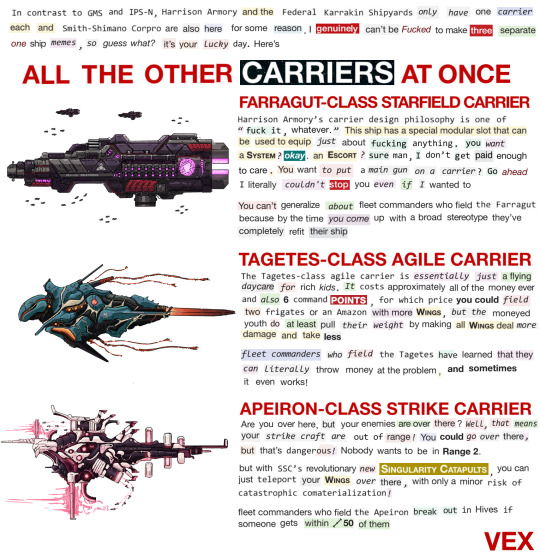Photo

Boston Post, Massachusetts, July 7, 1921
37K notes
·
View notes
Text
It's probably the old-school Dungeons & Dragons fan in me talking, but I love historical polearms that try to be every polearm at once. Like, it's a pike and an awl and a glaive and a billhook and it has an iron-banded haft for parrying and there's an extra spike on the butt-end in case you ever need to stab the guy standing behind you. Fucking "this is the thing they killed Medieval Shinzo Abe with"-ass weapons.
7K notes
·
View notes
Text
Happy Holidays, have my top 10 LANCER textmashes compiled together




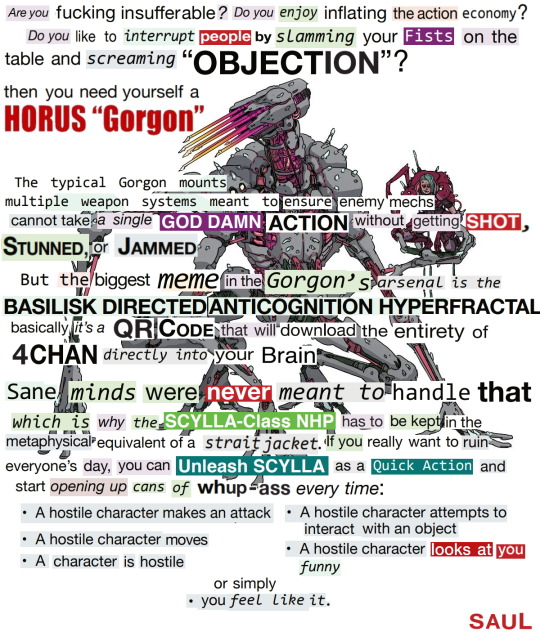
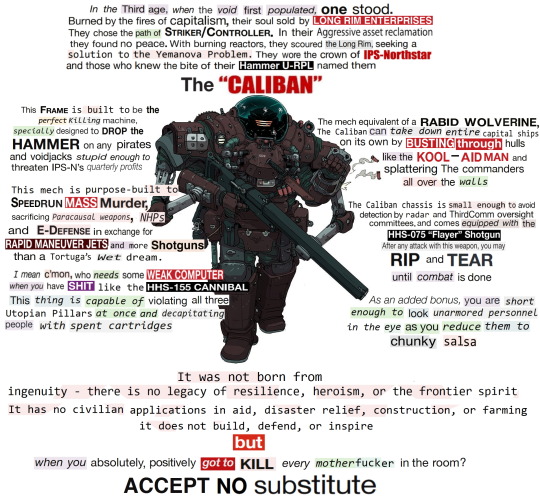

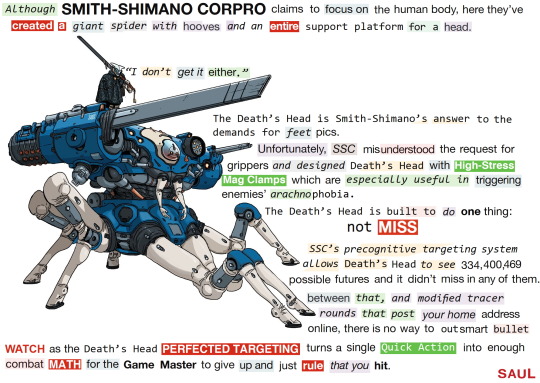

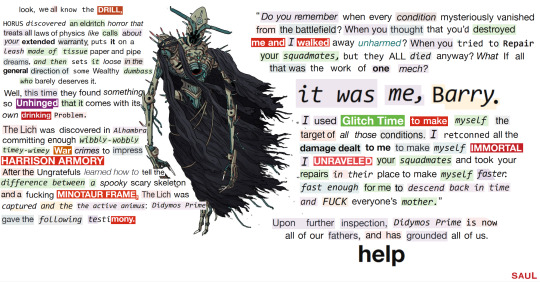
I'm glad y'all seem to enjoy these. Comcast's shit internet service is preventing me from gaming so I have more time to kill making these. Next on the list are the NELSON and the GOBLIN.
2K notes
·
View notes
Text
Fantasy stories should have more “what do you mean you don’t do X” things in compare and contrast of cultures. Like the differences between peoples aren’t the stuff they show off as “These Are Our Culture :)” things, fucking everyone has food and music and folk tales, but the things they’ve always assumed that everyone has, and are baffled to discover that they don’t.
The people who are always barefoot are baffled that humans don’t have a wash basin at their front door where people can wash their feet before stepping inside?? Do they just walk in with their dirty feet? The fuck do you mean you take your shoes off?
Humans don’t have small baby-sized spellbooks for toddlers who just learned to read, so they can safely learn to practice tiny cute and harmless, age-appropriate magic spells before progressing to more mature and demanding spells? What, do they just throw teenagers completely unprepared into the arcane - hold the fuck up, is that why human sorceror mortality is so fucking high?
Dwarves who have always wondered why the entrance to human residences is so fucking big, why do you need to take up such a large area for a door that’s just there to lead downstairs to the underground halls? Are the timber walls really as thick as a human is tall? What for? And once one of them gets invited to a human house to stay and rest, nobody ever fucking believes her: That’s not the entrance, that’s the whole fucking house. 100% of the human house is aboveground, there is no tunnel to the underground levels. They might have a single storage room down there, but the aboveground section is so fucking big because that’s the whole house.
This post was brought to you by: People who butter their bread and who had no idea that there are people who put mayonnaise on their bread, and people who put mayo on their bread and had no idea about people who put butter on their bread discovering that the other kind of people exist.
43K notes
·
View notes
Photo

happy christmas to my favourite story of all time
198K notes
·
View notes
Photo










A few of the more creative spellings of Santa Claus I’ve come across while looking for Dear Santa letters in old newspapers this year.
10K notes
·
View notes
Photo









A few of the more creative spellings of Christmas I’ve come across while looking for Dear Santa letters in old newspapers this year.
235K notes
·
View notes
Text
Hi new Tumblr users
Please know this sites hashtagging system is categorical and NOT clout based
Aka if I look up the “Wendell and Wild” tag, I should find clips, media, art and posts related to Wendell and wild ONLY. Same with any other random tag searched
If I spy a selfie, a random neighborhood, or any other kind of “insta” post trying to take likes for a popular hashtag, I’m reporting you for spam. Most other long term users will too and your acct will be fast tracked as a spam blogger and blocked.
You will not ruin the last non corporate site for us, especially by trying to treat this site like influencers matter. If you get popular, it’s bc you’re a clown w a skill not bc your hot or rich or skinny, got it?
113K notes
·
View notes
Text

River Spitters are strange predators that stalk freshwater lakes, rivers, and swamps. These monsters look like a cross between a newt and a seal, and tend to form small packs of 2-5 members that swim close to land. What sets these monsters apart from other aquatic attackers is their tendency to target anything they see with acid spit, with packs of spitters forming firing lines. When attacking, only their heads will breach the surface as they spit their caustic fluids at their target. They prefer to attack at range, swimming away quickly if approached. They will only move in to eat whatever they kill once its dead.
15 notes
·
View notes
Text

The Rocky Citadel by Martin Le Borgne
146 notes
·
View notes
Note
Do you have any tips for solid worldbuilding?
Signed, an amateur fantasy writer whose only prior fantasy worldbuilding knowledge was ToG and its ilk 😭😭😭
Don't get your ideas just from other fantasy books. Get inspiration mostly from real world things that are cool to you. Read non-fiction about stuff that is really interesting to you, even if it's just wikipedia articles. Then imagine what those things might be like in a fantasy world.
If there is any topic that you know a lot about, write that into your worldbuilding. If you know a lot about purebred cats, imagine fantasy purebred cats or purebred dragons. If you know a lot about cooking, go crazy with fantasy food. If you know a lot about fiber arts, guess what
Instead of trying to make up a "new" take on an existing mythological creature, just make something up.
Don't be judgmental. When you are building cultures, remember that cultural beliefs and practices exist for a reason, so always try to see their perspective of the world and why it is the way that it is. There is really no such thing as "superstition," only the tendency of humans to grasp at patterns in situations where they don't have control.
People who are the same religion can have very different beliefs and probably could end up arguing with each other. Also, not all religions are based on "belief/faith" or have heaven and hell, that's mostly Christianity.
Don't try to force big political events in your world to line up with the individual stories of characters; the evil ruler can get killed halfway through your story instead of at the climax of the story. Your character doesn't have to actually fight in the decisive battle that changes the course of history. Your character doesn't have to be a queen or "important figure." History doesn't have main characters; 99.9% of people are just some guy, and the .1% mostly THINK they're just some guy, and none of them understand the historical significance of an event as it's happening to them. Stories are happening all the time, they don't have to link directly to kings and empires.
BUT, if you want to write about main characters who are queens and princes and stuff, don't try to ground them in realistic political issues and down to earth explorations of social problems. Stories where the "main character of history" thing works are frequently interpersonal/familial dramas exaggerated to the world-wide stage AND/OR heavily mythologized to the point where the characters have a demi-god-like status AND/OR soap opera like dramas where everyone's vices and unusual traits and charisma are exaggerated. The climax of Star Wars or of Hamlet isn't ABOUT regime change, it's about the familial relationships of the characters.
Instead of trying to figure out big things like "culture," "food" etc, pay attention to your everyday life for a while and think about how your character would do things you do, like wash their hair or go out to buy food. Where does your character go to hang out? How do they clean their teeth? How do they learn the news?
Just make stuff up whenever you feel like it and you can write it all in throughout later.
Use sensory details to describe otherworldly things and be EXTREMELY specific and EXTREMELY confident about it. If your character drinks a potion, you have to describe the taste in a way that only someone who has drunk that potion could possibly be able to guess. So don't say it tasted "sour," say that it tasted like lemon rind, except with none of the fresh crispness of citrus, but instead a perfume-like burning that seemed to cling to the inside of your mouth and make your throat feel frostbitten.
If you think of an idea that feels a little TOO weird and bizarre, that's a sign that it's exactly the amount of weird and bizarre that it needs to be.
Ignore any of these pieces of advice that you want, don't listen to writing advice too much
2K notes
·
View notes
Text
Overland Travel as a Dungeon
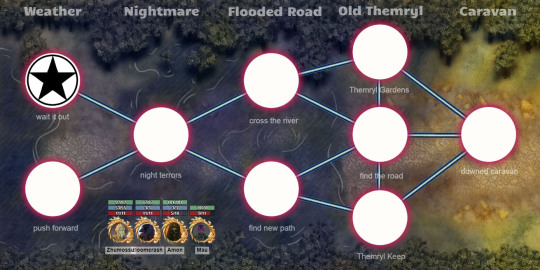
With D&D being canceled last night due to Roll20 issues, I’ve had time to do extra prepwork! I’m trying something new to take the tedium out of overland travel by making it more like a dungeon with “rooms” depending on the choices the players make (the labels are GM-only for my own reference)
I’m also making Long Rests during travel more difficult (so I don’t have to challenge them with deadly encounters at every step): Each long rest, players will need to choose between regaining their hit points, regaining half their max hit dice, or regaining their spell slots/long-rest-recharging features. In other words, three long rests will end up equaling 1 true long rest. They can choose the same thing multiple times in a row.
All encounters are established ahead of time, but which ones they encounter are based on their decisions. My rules for designing the encounters:
75% of encounters must progress the story (7/9 advance the plot here)
Each must be foreshadowed in the players’ options. They should know the extent of dangers of their choices.
50% should be non-combat (traps, RP, skill challenge, etc)
Here are the encounters the players face while in the swamp:
Inclement Weather
A torrential rainstorm begins to rage. (these ones are non-plot encounters)
Seek cover and wait it out: The tree the players rest beneath loosens from a rush of water and falls over, burying and suffocating those that fail the save. Three successful Athletics checks frees them.
Keep moving carefully: A spinosaurus hunts the players using the rain to cover its approach.
Night Terrors
There are no encounters during the day but the players will need to make survival checks to stay on the newly-flooded path. At night, our warlock-turned-wizard has dreams relating to their shadowy ex-patron, who desperately wants control of her back but an amulet is keeping the patron at bay. When she awakens, one of her allies was mind-controlled into stealing the amulet and throwing it into the muck. After the charm fades, shadow stags attack once the warlock is vulnerable (I took large Giant Elks and combined them with undead Shadows, and had their dash create a trail of magic darkness).
Flooded Path
The road passes through a valley that got flooded by the rain.
Cross the Water: The players spot a crocodile in the water. It ignores them for now but it seems the water might be dangerous. They will also need to figure out how they are doing it (boat, swimming?) and make checks. Lizardfolk and a giant crocodile relating to the players’ past can be encountered here. They are hunting and will attack initially, but the players might be able to end combat early if they persuade them.
Find a Way Around: There is a forest filled with strange green mist, similar to a corrupted plant-hydra they saw earlier. They will need to make survival checks and regret not letting the ranger from last session help them. A hag has been corrupting the land near here, and they will get attacked by 3x owlbears with a 5′ poison aura and corrosive claws.
Old Themryl
Depending on which ways the players went, they can access different parts of an old kingdom or try to find the main road again (but, nearing the exit of the swamps, the players might want to lay low for story reasons). The other story stuff in this fork is hard to explain lacking context so I will just explain the encounters.
Investigate skulls on pikes: The players can find Themryl Gardens, a cemetery desecrated by skulls on pikes with glowing eyes. It is currently being raided by a blackguard with 3 skeleton servants. He is trying to break into a mausoleum but his skeletons are too weak. If disturbed, he summons two Flameskulls from the pikes nearby to attack.
Inside the mausoleum is a Spectator guardian. A glyph of warding trap is on a sarcophagus, which also has a secret compartment with story stuff and treasure. the corpse within is also story-related and leads to Old Themryl Keep for the other half of the info.
Find the Road: The players meet a bard belonging to their destination’s innkeepers’ guild. He seeks Old Themryl and will pay handsomely to be led there to gain inspiration for his songs. Players can ignore him if they choose, but at least they will learn about the plot dungeons if they wish to return.
Investigate the bodies: Players find bodies riddled with arrow wounds (but no arrows), crawling away from a thicket before they died. In the thicket is the half-sunken ruins of Old Themryl Keep. It is protected by Sword Wraiths (but with stats for longbows) on the battlements.
Inside, there is a simple statue puzzle and mysterious ghostly antics. The puzzle opens the next chamber.
Next room is a hallway with two normal sword wraiths. One door in the hall is caved in. Another door will open but buries the door opener in muck (trap). Last door leads to a grand hall.
Grand hall is knee-deep in water with rubble islands and a throne peeking above surface. Sword Wraith Commander is here, and summon other sword wraiths. The commander deals bonus lightning instead of necrotic and has a lair action on round 20 where he electrifies the water for a high amount of damage. Players can avoid by the islands or throne, but the minions may push them in. If put to rest, story stuff happens.
Last room has a noble’s treasure and a handmaid’s journal that dispenses plot, and leads to the cemetery for the other half of the info.
Downed Caravan
The players come by a caravan trying to fix their wheels/axle and trying to treat wounded members. One would think they were attacked by bandits, but in reality it was a patrol of corrupt soldiers demanding tax from these merchants from an enemy kingdom from New Themryl (the PCs destination). If the players help the group, they are offered a way into an enemy kingdom with shelter, and rewarded with some of their goods. If not, well… the PCs don’t gain anything. They’re just assholes.
—
And then the players arrive at their destination!
There were multiple paths, options to backtrack and explore, RP elements, mini-dungeons, skill checks, puzzles, traps, and big monsters… just like any dungeon! Feel free to steal any of this and especially the concept of “travel as dungeon” because I think it’s going to be more fun. But we will find out on our next session of the Dorkvision stream! (Sundays 9PM-12 eastern and wednesdays 7-10PM - https://www.twitch.tv/noblecrumpet)
575 notes
·
View notes
Text
Heroes are all fucked up
I know this has been said before in a thousand different ways by a thousand different people and some of them said it better than me, but it's on my mind and so here goes:
Heroes are deeply fucked up people
The answer to "why would any normal person pick up a sword and go diving into caves full of monsters/strap themselves into a ten-ton death machine/fly between worlds in their spaceship doing crimes" is "no normal person would" because nobody with a happy, fulfilling life would need to.
Something happened to every D&D character that made them either want or need to put themselves in terrible danger on a regular basis. Something happened to every mech pilot in Lancer that makes them keep climbing into a walking weapon despite the risk. They don't have to enjoy what they're doing, they might hate it, but they need it because something happened to them that made them this way.
Firefly wasn't a perfect show, and not every aspect of it aged well, but it's such a good example of this. Malcolm Reynolds is a guy who believed in something enough to fight and kill for it, and he got to watch most of the people who trusted him die. Now he travels from place to place in a beaten up old trashfire of a ship putting himself in constant danger because it Makes The Thoughts Stop, and he tries to pass himself off as uncaring but he just can't help himself when an opportunity to do the right thing arises, because maybe, just maybe, if he does enough good things, maybe it will make up for his failures.
"Why do so many OCs have a tragic backstory" because we like to write about things that are interesting and the kind of people who live very happy, untroubled lives are not very interesting
921 notes
·
View notes
Photo
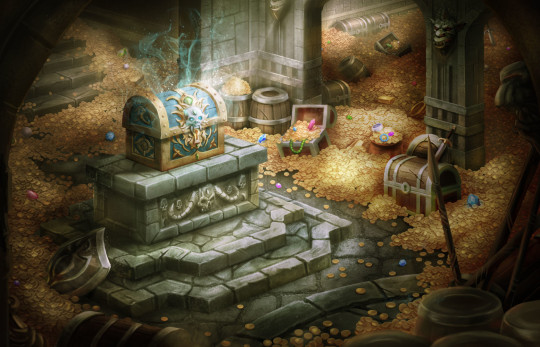
DM Tip: Better Loot
Treasure is ubiquitous in D&D, it’s presumed to be one of the default motivations, if not the only motivation behind many adventures, despite the fact that very little thought has been put into the systems by which the DM generates the treasure and the party plays around with it. After nearly two decades of being a DM I can’t count the number of times I’ve made a treasure horde and handed it out to the players while feeling as if the fun game we had been playing had suddenly been put on pause.
It took me a while to realize that this was because unlike combat ( the favourite child among d&d’s many subsystems) very little attention had been made to making loot feel good at any stage of the process whether it was down to the mechanics or even the presentation.
While below the cut I’m going to get into systems about easier ways to generate treasure, rebalanced magic item prices, and how to get your players in on the fun, for now I want to focus on this element of presentation when it comes to handing out loot.
Here’s some of my findings, in no particular order:
Just like combat has “ Roll initiative” and “how do you want to do this?”, handing out loot should have codified phrases to indicate that the party is entering into a specific period of game time. It’s a ritual that will not only get them excited but have them in the right kind of headspace required for absorbing new information. The phrases I’ve been using are “ You spill out your plunder across the table/dungeon floor and there you find_____” and “With that sorted, you pack away your spoils, and return to the adventure at hand”
I completely ignore art items/gems, they’re a neat idea for flavor but they slow things down at every turn ( coming up with them during loot generations, players recording them) and are almost always junked for gp at the first possible opportunity. The exception to this is valuable trade goods/collectors items, which I mention being worth X gp in value but worth MORE if the party can find an associated merchant ( as a questhook)
GP comes first, followed by the names of the items and a brief as possible physical description. Players can ask questions generally on what items do but either have to call dibs then or divy them up on their own time. Listening to the dm dispassionately read out the stats of an item is boring as hell, only eclipsed by the dm describing the indepth LOOK of various items and then asking the party to roll checks to identify/figure out of the items work. Speed in divvying loot keeps the momentum of the game going and you want to tap into the “OOOH, SHINY” impulse of your players before their eyes glaze over.
I HIGHLY suggest keeping a party doc with the stats of all your items copy/pasted into it. Divide the doc up by characters/in the cart, so your party can always remember where shit was. Ask one organized player to be the one to keep track of the party doc and share it with the others. Call them “quartermaster” they’ll love that shit.
Unless the item in question needs to be used immediately “ It’ll be in the party doc” is your answer when they ask for stats. Update the partydoc after session so your group can have the whole week to look at it and get used to things between sessions. Gearing up with new loot is just as much homework as leveling up a character, and is best done away from the table.
After you’re done checking out the treasure generation rules below, also be sure to check out my systems on handling shopping trips, making identifying items more interesting, and managing party wealth. I’m sure you’ll find something there that can help improve your game.
Keep reading
611 notes
·
View notes
Photo

Adventure Seeds: The Royal Drake Riders
Civilizations that lay claim to wide stretches of desert territory require some means of traversing it, traditionally by chariot, camel back, or river travel. In a fantasy world, domesticated beasts capable of flight would prove invaluable to such a culture, as they would be able to carry a rider from one far off settlement to another, allowing communication, scouting, and military pressure to be spread across vast distances.
The royal drake riders are seen as the living will of the kingdom, carrying the pharaoh’s dictates to the far corners of the realm along with news from afar. They maintain a fortress in every major city, and only recruit the best and most loyal of soldiers. When the heroes come across a critically wounded rider and their dying mount, it’s up to them to deliver an important message to the local governor before those who grounded the courier catch up.
Feeding beasts capable of traversing the horizon in a single day takes a lot of logistics. When the air cavalry’s reserved food supply suddenly falls prey to illness, problems quickly begin to snowball after a hungry drake breaks free of its pen and goes on a rampage in a nearby caravansary. Angry merchants must be appeased, farmers must be negotiated with for a new supply, and it’s impossible to rule out sabotage as the source of the feedherd’s sickness. It’s all too much for the garrison commander to deal with on their own, so they put out a call for help to an old friend of theirs that happens to be an adventurer.
An ancient civilization used drakes as messengers and warbeasts, leading to a propagation of their kind throughout the breadth of their empire. When the desert encroached and the empire fell, the drakes went wild, using the old courier stations as nesting grounds and have harassed travellers through the desert ever since. Now a new power wants to create a trade route through the desert, and will hire any sellsword they can in order to clear the strategically placed ruins of their draconic inhabitants.
172 notes
·
View notes



